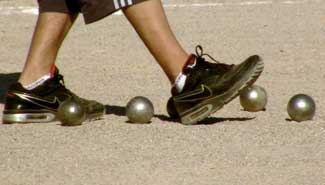Having a Boule with Pétanque

In grade school, I competitively played volleyball and basketball. In high school, my golf and tennis teams went to the state competition every single year. I have been a University of Kentucky basketball fan since I could breathe, and the phrase "Roll Tide" has a use for every situation in my life. I thought I knew everything there was to know about sports around the world. Then I met my match.
My first experience with this French sport came in Collioure when I saw some elderly men playing a game with metal balls on a lawn by the beach.
"Oh hey, look, they're playing pétanque!" exclaimed my fellow student Justine Dhollande.
"Peh-what?" I inquired. The metal balls lying on the crisp green grass reminded me of an outdoor game that I used to play as a child, bocce ball.
Justine, who has family from the area, explained the game as the men threw the balls, which, one by one, hit the grass with a thump.
Pétanque is a sport where players throw metal balls, or boules, toward another smaller wooden ball known as the cochonet. To earn points you must place your ball as close to the cochonet as possible without hitting it.
To be honest, the activity appeared to be boring and old-fashioned. The men stood around chatting and smoking, only occasionally stopping to pick up a ball and throw it. I was shocked to hear Justine even acknowledge it as a sport.
"This is not a sport. Football is a sport," I thought to myself.
After learning a little bit more, I made pétanque my topic for my feature story. I was not ready to accept it as a legitimate sport. Where was the exertion? Where was the sweat? And what sport allows its players to smoke?
Just days later I found myself at Perpignan's Parc des Sports for an interview with Patrick and Thierry Pedragosa, two brothers who are among Perpignan's most famous pétanque players. My interpreter and I stayed to watch the tournament that took place later on the park's dirt court.
According to Perpignan Committee President Jean Villarem, more than 140 men competed side-by-side in the tournament for a chance to compete in the "Grand Prix Delaville" alongside many world champions. There was no shade and no water for the players. Dust covered my toes and clouded my eyesight and the heat was unbearable, even at 9 a.m. The tournament lasted until 8 p.m. and those who won were expected to compete again the following day.
After one hour of baking in the sun, I decided that I had been too quick to pass judgment based on my first impression of the game I saw in Collioure. While the physical contact might be minimal, competitive players must be mentally prepared for long hours and physically exhausting conditions just like many other sports.
Although I cannot say that I'll be trading my golf clubs in for a set of boules any time soon, pétanque has reawakened my passion for sports, and made me realize that there's always more than what meets the eye.
Recent Posts
The Cloth of the Sun by Su Kim
The Sculptor and his Wife by Mary Barczak
The Language Barrier by Jim Cameron
The Sixth Sense: Understanding by Christina Cocca
Bastille Day Bees by Annie Petersen
Reaching New Heights by Sarah Raghubir
Vive Perpignan by Chelsea Boone
The Changing Collioure Art Scene by Ariana Bacle
Having a Boule with Pétanque by Kristin O'Brien
Corridas in the 21st Century by Victoria King
Controversy Fermenting? by Marika Washchyshyn
A Different Culinary Landscape by Simon Arseneau
Student Pages
Simon Arseneau
Ariana Bacle
Mary Barczak
Chelsea Boone
Jim Cameron
Christina Cocca
Justine Dhollande
Su Kim
Victoria King
Kristin O'Brien
Annie Petersen
Sarah Raghubir
Alexis Sanchez
Maegan Simmons
Marika Washchyshyn
About the Program
Fifteen college students came from North America to Perpignan, France, in June 2011 to produce these videos and stories. To find out more, read a welcome letter from program director Rachele Kanigel, meet the program faculty and explore the 2010 website.

